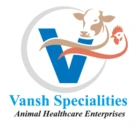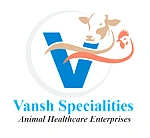
Unravelling the Growth Conundrum in Poultry: Tackling the core challenge
The poultry industry has long relied on antibiotic growth promoters (AGPs) to enhance growth rates, improve feed efficiency, and prevent diseases in crowded farming environments. However, the increasing concerns over antibiotic resistance and its impact on human health have led many countries to implement bans on AGPs. This regulatory shift presents a significant challenge for poultry producers, as they must find effective alternatives to support healthy, fast-growing birds without compromising animal welfare or production efficiency.
Current Use of Antibiotic Growth Promoters
1. Purpose in Poultry Production:
- Growth Performance: AGPs improve weight gain and growth rates by reducing microbial competition for nutrients in the gut.
- Disease Prevention: They help control pathogenic bacteria like Clostridium perfringens, reducing the incidence of enteritis and other diseases.
- Feed Efficiency: By improving gut health, AGPs enhance feed conversion ratios (FCR), ensuring maximum utilisation of nutrients.
2. Common Antibiotics Used as AGPs:
- Tetracyclines: Broad-spectrum antibiotics effective against a variety of bacterial pathogens.
- Bacitracin: Effective against gram-positive bacteria, commonly used to prevent necrotic enteritis.
- Macrolides: Includes tylosin, used to reduce respiratory diseases and improve gut health.
- Ionophores: Such as monensin, primarily used to control coccidiosis and improve feed efficiency.
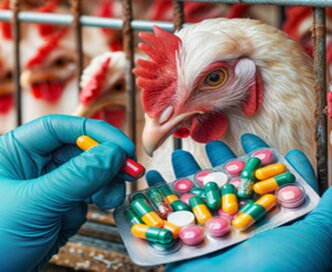
3. Global Trends in Usage
Countries with Bans or Restrictions:
- The European Union banned all AGPs in 2006, focusing on public health and animal welfare. The United States implemented the Veterinary Feed Directive (VFD) in 2017, restricting the use of medically important antibiotics for growth promotion. The South Korea and other developed nations have similarly restricted AGP use.
- In many developing countries, including India, China, and Brazil, AGPs remain in use due to lower costs and insufficient regulatory enforcement.
4. Regulatory and Consumer Demand
• Changing Consumer Expectations: With growing consumer awareness of the risks associated with AGPs, there is an increasing demand for antibiotic-free poultry products. While this is a positive trend for consumer health, it puts additional pressure on poultry producers to adapt quickly and find alternatives that meet these demands.
• Regulatory Compliance: Producers must navigate shifting regulatory landscapes in different countries, which may vary in terms of the timeline for AGP bans, permissible substitutes, and certification requirements for antibiotic-free poultry.
5. Animal Welfare and Ethical Concerns
• The removal of AGPs also raises concerns regarding animal welfare, as producers must ensure that birds remain healthy in environments that no longer benefit from the growth-enhancing effects of antibiotics. Maintaining high health standards without relying on antibiotics requires a more holistic approach to disease prevention and overall flock management.
The challenge of “Unraveling the Growth Conundrum in Poultry” in the absence of antibiotic growth promoters is multi-dimensional, involving the need for innovation in animal nutrition, disease management, and overall flock management. Poultry producers must adapt to the evolving regulatory environment while balancing the costs and potential risks of AGP alternatives. Success in overcoming this challenge lies in developing sustainable and effective strategies that ensure the health, welfare, and productivity of poultry without compromising public health or consumer trust.
The challenge of “Unraveling the Growth Conundrum in Poultry” in the absence of antibiotic growth promoters is multi-dimensional, involving the need for innovation in animal nutrition, disease management, and overall flock management. Poultry producers must adapt to the evolving regulatory environment while balancing the costs and potential risks of AGP alternatives. Success in overcoming this challenge lies in developing sustainable and effective strategies that ensure the health, welfare, and productivity of poultry without compromising public health or consumer trust.
1. Health and Growth Impact of AGP Ban
• Growth Retardation: Without AGPs, poultry farmers may face slower growth rates due to the lack of enhanced feed efficiency. Birds may also experience higher mortality rates or more frequent disease outbreaks, leading to economic losses.
• Increased Disease Pressure: Antibiotics have traditionally helped prevent bacterial infections in poultry. Without them, poultry are more vulnerable to diseases, which can negatively impact overall flock health and growth potential.
2. Challenges in Alternative Solutions
• Lack of Effective Alternatives: While several alternatives like probiotics, prebiotics, and phytogenics have shown promise in improving poultry health, they often do not provide the same immediate, broad-spectrum benefits as antibiotics. Finding effective and cost-efficient replacements is a major hurdle for farmers.
• Nutritional Adjustments: Without AGPs, nutritional management becomes more critical. Optimising diets with the right balance of vitamins, minerals, and amino acids is essential to ensure growth and immunity, requiring careful formulation and monitoring.
3. Increased Operational Costs
• Higher Feed Costs: The absence of AGPs often leads to the need for more specialized feeds and supplements to promote growth and prevent disease, which can drive up operational costs.
• Increased Veterinary Care: With higher disease pressure, more frequent veterinary intervention may be required, leading to additional expenses in terms of medications, treatments, and staff time.
Human Health and Consequences of Using Antibiotic Growth Promoters
1. Antimicrobial
Resistance (AMR):
•
Selective Pressure: The
use of AGPs at low doses over extended periods promotes the survival of
antibiotic-resistant bacteria.
•
Horizontal Gene Transfer:
Resistant bacteria in poultry can transfer resistance genes to human pathogens
through plasmids, increasing AMR prevalence.
•
Impact: WHO
considers AMR one of the top global health threats, with resistant infections
causing over 1.27 million deaths annually worldwide.
2.
Food borne Pathogens:
•
Common resistant pathogens include Salmonella spp., Campylobacter
jejuni, and Escherichia coli
with
antibiotic resistance due to AGP use, pose significant public health risks,
including outbreaks of food borne illnesses that are more difficult to treat.
•
These bacteria can survive in poultry meat and eggs, posing risks to consumers.
3.
Disruption of Human Microbiota:
•
Resistant bacteria from poultry products can colonise the human gut, altering
the microbiota balance and potentially causing gastrointestinal diseases and
reduced efficacy of antibiotic treatments.
4.
Healthcare Costs and Public Health Risks:
•
Resistant infections result in longer hospital stays, increased treatment
costs, and higher mortality rates due to limited therapeutic options.
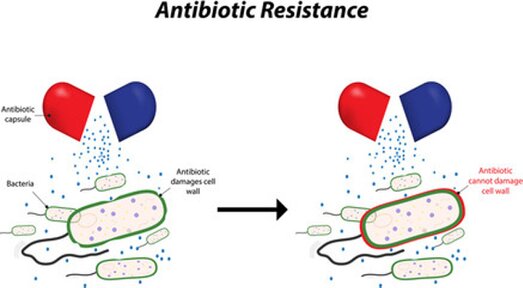
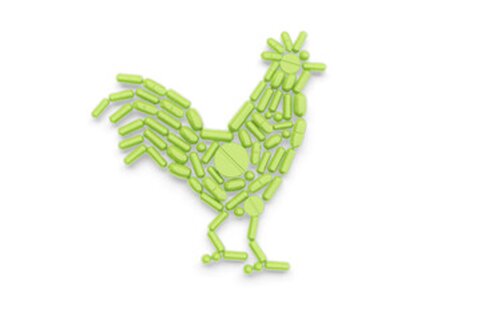
At Vansh Specialities, we offer ReWallVe, The science of growth, the art of natural performance. Replace AGPs with a proven solution that transforms gut health, optimizes nutrient absorption, and boosts immunity—naturally, sustainably, and effectively.
The Alternatives to Antibiotic Growth Promoters
In considering phasing out or banning antibiotic growth promoters, the quality of any alternatives, either on the market, that could be developed or that are available illegally must be assessed. Essentially, there are two ways in which we can reduce our dependence on antibiotic use in animals. An obvious choice is the development of alternatives to antibiotics that work via similar mechanisms, promoting growth whilst enhancing the efficiency of feed conversion. A more difficult route would be to improve animal health. Growth promoters have been shown (Prescott & Baggot, 1993) to perform best when conditions are worst: i.e. when the animal is in poor health and the living conditions unhygienic. If their local environment is improved, with overcrowding reduced and infection control techniques introduced, then the actual need for growth promoters may be removed.

ReWallVe
ReWallVe is a scientifically formulated, natural growth promotor that redefines animal performance by leveraging cutting edge innovations in feed technology. Engineered as a potent replacement for antibiotic growth promoters (AGPs), it offers a sustainable, residue free solution to the challenges of modern animal production.
By promoting a balanced gut microbiota and reducing pathogenic challenges, ReWallVe supports digestive health and immune function, thereby minimizing growth setbacks and enhancing overall productivity. Its comprehensive formulation of bioactive compounds supports robust skeletal development and muscular growth, translating to healthier, more resilient animals- Naturally, Sustainably and Effectively.

Stress and Behavioural Impact
Adaptogenic components
components in ReWallVe alleviate stress-related depressive symptoms by modulating stress hormones and promoting physiological homeostasis.
Immune Modulation
The antioxidant properties of ReWallVe combat oxidative stress and enhance immune cell activity. This supports an overall stronger immune response and reduces susceptibility to diseases.
Appetite Stimulation and Palatability Enhancement
ReWallve contains natural flavouring compounds like alkaloids, also activate olfactory and gustatory receptors, enhancing feed palatability and stimulating appetite. This leads to increased feed intake and improved energy availability for metabolic functions.
Reproductive Efficiency
ReWallVe improves reproductive outcomes by optimizing energy partitioning and supporting hormonal balance, reducing the risk of stillbirths and improving fertility rates.
Gastrointestinal Function
ReWallVe contains prebiotics promotes gastric motility and regulates gastric emptying by modulating gastrointestinal hormones. This helps to manage digestive disorders and maintain a balanced gut environment.
Nutrient and Energy Digestibility
The inclusion of specific enzymes and organic acids in ReWallVe improves the breakdown of complex nutrients, facilitating their efficient digestion and absorption in the gastrointestinal tract.
ReWallVe Benefits Across Animal Species

Aquaculture
- Improves fertility and reproduction rates in fish and shrimp.
- Higher feed and energy reserve for larval development.
- Reduces stress and enhances resilience to disease.
- Improve utilisation efficiency of plant based proteins.
- Decrease phosphorus load in the aquatic environment.
Poultry
- Accelerates growth of animals at early stage of life.
- Enhances fertility and hatchability.
- Enables uniform and fast growth to marketable body weight.
- Enhance egg yolk colour.
- Improves meat quality with no residue.
Sows
- Boosts lactation in sows.
- Accelerates recovery after reproduction for improved productivity.
- Increase farrowing rate.
- Increase number of live born piglets per litter and Decrease still birth.
- Reduces Stress due to farming conditions.
Benefits of ReWallVe
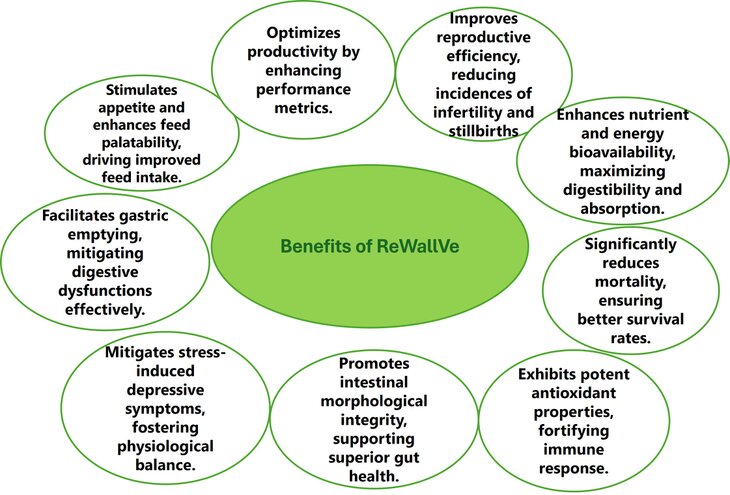
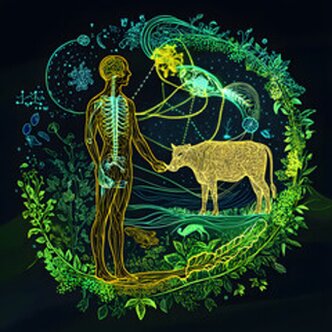
Why Choose ReWallVe Over Antibiotics?
The Future of Sustainable Animal Health
ReWallVe replaces antibiotic growth promoters with a natural, effective alternative. Unlike antibiotics.ReWallVe enhances growth and fertility without contributing to antimicrobial resistance. This makes it the ideal choice for future-focused, responsible farming and aquaculture.
